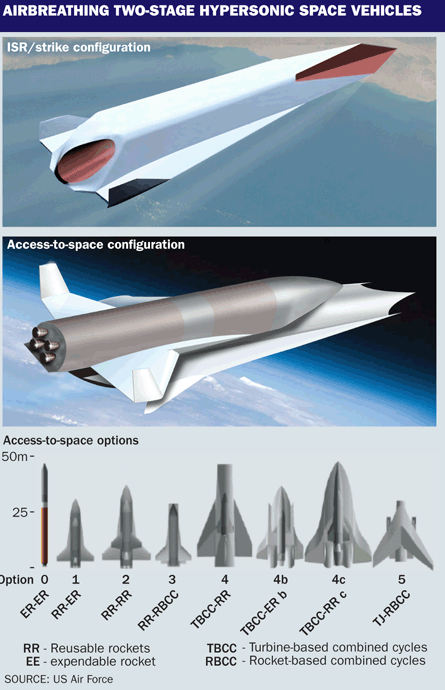As US military and space officials develop the outlines for a new generation of hypersonic vehicles, a tiny, Maryland-based company named Astrox has assumed a key role in shaping the designs and defining their performance.
For more than a decade Astrox worked in semi-obscurity on several major hypersonic programmes, including the NASA X-43A scramjet and the Defense Advanced Research projects Agency (DARPA) Blackswift.
But Astrox's public exposure increased dramatically in July with the public release of "Technology Horizons", a 20-year roadmap for science and technology advances published by Werner Dahm, chief scientist of the US Air Force.
Astrox is credited within the 171-page document for all-new images showing designs for a very different kind of hypersonic vehicle than those in testing today, such as the Boeing/Pratt & Whitney X-51 Waverider.
The designs are revealed after two setbacks in the hypersonics community. In April, DARPA's hypersonic test vehicle HTV-3 disintegrated about 9min into a 30min flight test over the Pacific Ocean.
One month later, the X-51A flight was cut short as a result of a suspected problem with a seal on the exhaust nozzle. The vehicle achieved a top speed of Mach 4.9, well short of the programme's goal to reach M6. At the same time, the X-51A recorded 13 times the endurance of the X-43A, so the test nevertheless generated a wealth of new flight data at hypersonic speeds.
 |
|---|
Astrox president Ajay Kothari confirms the combined-cycle design concepts - which include several options for a two-stage-to-orbit reusable space vehicle and a rocket-scramjet-powered hypersonic vehicle - are the focus of a joint study by the Air Force Research Laboratory (AFRL) and NASA.
Mark Lewis, Dahm's predecessor as USAF chief scientist, describes the Astrox designs revealed in Technology Horizons as a "benchmark" concept for the new hypersonic vehicles.
Astrox has developed what Lewis calls a "mid-fidelity" analytical tool to automatically show likely configurations and performance based on criteria such as inlet shaping and energy sources for thrust.
Each of the designs comes from a 2007 study commissioned by Lewis for Astrox to analyse new options for a follow-on to the X-51A.
The results of that analysis have launched a joint study between the AFRL and NASA. Both agencies are already plotting the next series of test and operational hypersonic vehicles.
Meanwhile, officials within AFRL are working to establish a new programme of record called Gryphon to succeed the X-51A, Lewis says. The Astrox concept for a long-range, hypersonic strike and surveillance vehicle, which is revealed in the Technology Horizons report, is considered a leading candidate.
Both the AFRL and NASA are also working on reusable, two-stage-to-orbit launch vehicles to eventually replace the evolved expendable launch vehicle and the Space Shuttle, which is scheduled for retirement early in 2011.
RADICAL DEPARTURES
Astrox has developed designs for the hypersonic missile and the reusable launch vehicle requirements.
In both cases, Astrox has proposed two radical departures from the design convention of the X-51A, one of the most successful hypersonic vehicles to date after only one test flight.
The X-51A features a rectangular inlet to slow the airflow from hypersonic to supersonic speed upon reaching the combustor. Although the two-dimensional surface of the rectangle is easier to model, the geometry creates more surface area that must be cooled. At hypersonic speeds, the uncooled inlet structure would melt without active cooling.
In the Astrox designs, the rectangular inlet shaping is replaced by a circular, inward-turning inlet. This funnel-shaped flowpath, which also was used by the cancelled Blackswift concept, is considered by some to be the next evolution in hypersonic design technology. Lewis says: "It turns out there's a lot of advantages to going to a round inlet."
In a second major departure, Astrox's design concepts all depend upon on vertical take-off.
Lewis compared the historical argument between vertical take-off and horizontal take-off for a reusable launch vehicle to a "religious dispute", for which he considers himself an agnostic.
Kothari, however, favours the vertical take-off method. "Horizontal take-off is the wrong way," he says. He blames a requirement for making Blackswift take off from a runway for the project's demise.
"By trying to take off horizontally using turbines, that becomes a boondoggle," Kothari says.
Each of the designs also include some combination of a rocket- or turbine-based stage and an air-breathing stage. The latter is considered more efficient because the vehicle is not required to lift off with its own supply of liquid oxygen to convert into fuel.
Astrox considers the concepts to be viable for beyond military purposes. Kothari is about to present a paper at the annual space conference organised by the American Institute for Aeronautics and Astronautics on the application of a combined-cycle, reusable launch vehicle for the commercial space market.
Source: Flight International












































